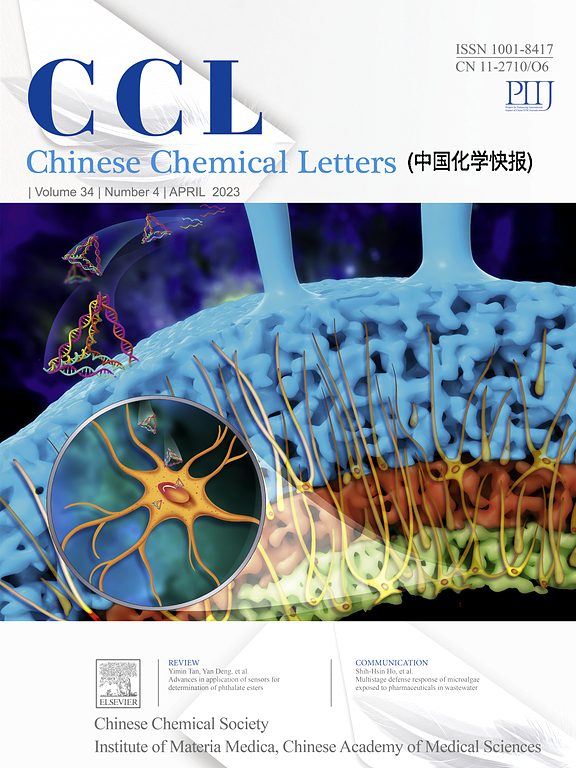锂金属阳极亲石电解质添加剂对锂枝晶脱溶障碍和抑制作用的调节
IF 8.9
1区 化学
Q1 CHEMISTRY, MULTIDISCIPLINARY
引用次数: 0
摘要
金属锂因其较高的理论比容量和较低的电化学电位而成为提高二次电池能量密度的极具前景的负极材料。然而,与锂枝晶引起的短路和不理想的电化学性能相关的安全问题阻碍了锂金属电池的商业可行性。目前的研究主要集中在通过改变集流器或引入电解质添加剂来改变Li+的溶剂化结构,以降低成核势垒,加速脱溶过程,抑制锂枝晶的生长。然而,结合这两种战略的优点的综合方法仍然难以捉摸。在这项研究中,我们成功地使用了亲石性质的金属有机盐添加剂来加速脱溶过程,降低Li+的成核屏障,并调节其溶剂化结构。该方法提高了锂箔表面固体电解质界面(SEI)中无机化合物的含量,导致Li+的稳定沉积和溶出。具体来说,Li||Cu电池在0.5 mA/cm2@0.5 mAh/cm2和1 mA/cm2@1 mAh/cm2的循环寿命和库仑效率分别为97.28%和98.59%,循环次数分别为410和240次。Li||锂对称电池在1 mA/cm2@1 mAh/cm2下放电1150 h未出现短路,Li||LFP电池在N/P(1.1:1.0)电流密度为1 C的条件下,在250次循环后仍能保持68.9%的容量(104.6 mAh/g)。本文章由计算机程序翻译,如有差异,请以英文原文为准。

Modulation of desolvation barriers and inhibition of lithium dendrites based on lithophilic electrolyte additives for lithium metal anode
Lithium metal has emerged as a highly promising anode material for enhancing the energy density of secondary batteries, attributed to its high theoretical specific capacity and low electrochemical potential. However, safety concerns related to lithium dendrite-induced short circuits and suboptimal electrochemical performance have impeded the commercial viability of lithium metal batteries. Current research efforts primarily focus on altering the solvated structure of Li+ by modifying the current collector or introducing electrolyte additives to lower the nucleation barrier, expedite the desolvation process, and suppress the growth of lithium dendrites. Nevertheless, an integrated approach that combines the advantages of these two strategies remains elusive. In this study, we successfully employed metal-organic salt additives with lithophilic properties to accelerate the desolvation process, reduce the nucleation barrier of Li+, and modulate its solvated structure. This approach enhanced the inorganic compound content in the solid electrolyte interphase (SEI) on lithium foil surfaces, leading to stable Li+ deposition and stripping. Specifically, Li||Cu cells demonstrated excellent cycle life and Coulombic efficiency (97.28% and 98.59%, respectively) at 0.5 mA/cm2@0.5 mAh/cm2 and 1 mA/cm2@1 mAh/cm2 for 410 and 240 cycles, respectively. Li||Li symmetrical cells showed no short circuit at 1 mA/cm2@1 mAh/cm2 for 1150 h, and Li||LFP full cells retained 68.9% of their capacity (104.6 mAh/g) after 250 cycles at N/P (1.1:1.0) with a current density of 1 C.
求助全文
通过发布文献求助,成功后即可免费获取论文全文。
去求助
来源期刊

Chinese Chemical Letters
化学-化学综合
CiteScore
14.10
自引率
15.40%
发文量
8969
审稿时长
1.6 months
期刊介绍:
Chinese Chemical Letters (CCL) (ISSN 1001-8417) was founded in July 1990. The journal publishes preliminary accounts in the whole field of chemistry, including inorganic chemistry, organic chemistry, analytical chemistry, physical chemistry, polymer chemistry, applied chemistry, etc.Chinese Chemical Letters does not accept articles previously published or scheduled to be published. To verify originality, your article may be checked by the originality detection service CrossCheck.
 求助内容:
求助内容: 应助结果提醒方式:
应助结果提醒方式:


